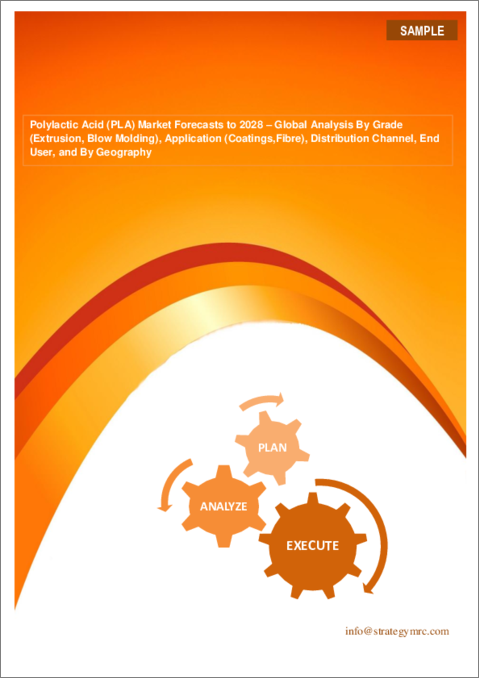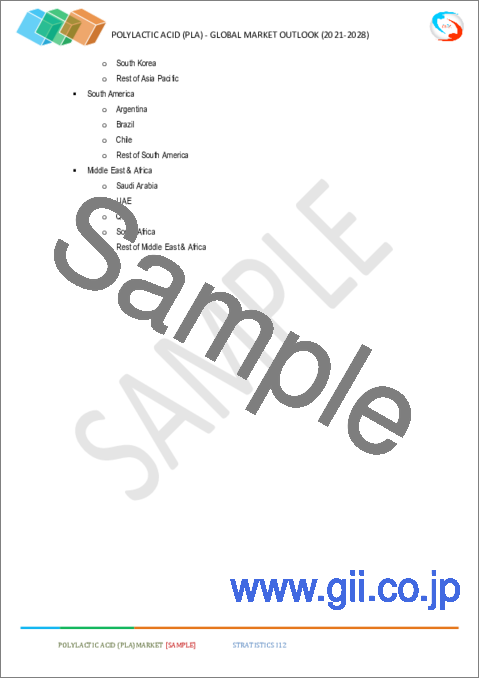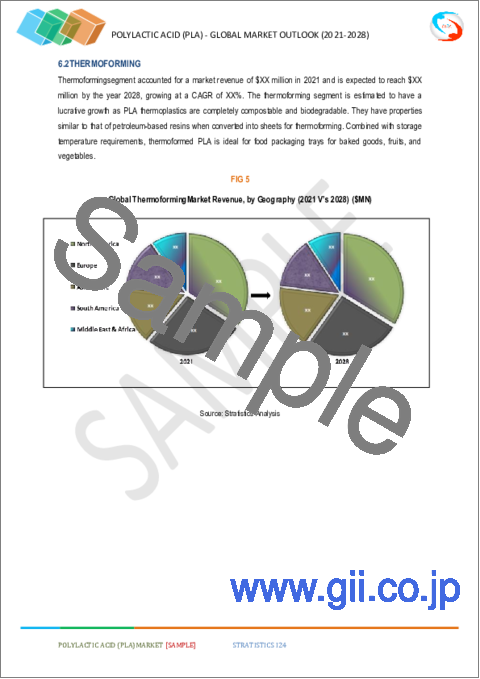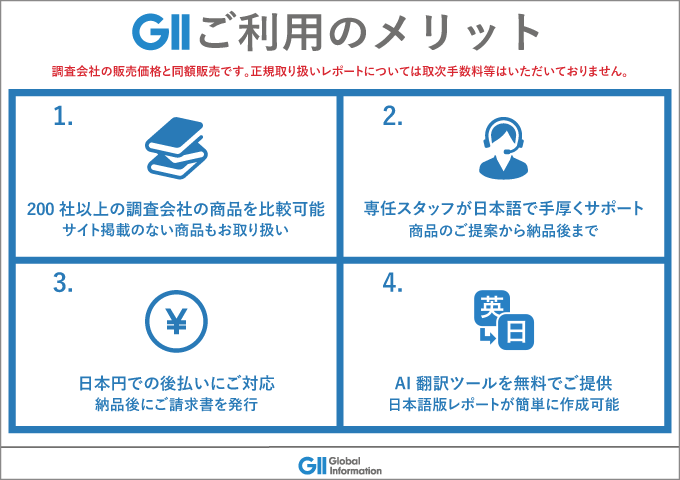|
|
市場調査レポート
商品コード
1074794
ポリ乳酸(PLA)の世界市場:グレード別(押出、ブロー成形)、用途別(コーティング、繊維)、流通チャネル別、エンドユーザー別、地域別分析 - 予測(2028年まで)Polylactic Acid (PLA) Market Forecasts to 2028 - Global Analysis By Grade (Extrusion, Blow Molding), Application (Coatings,Fibre), Distribution Channel, End User, and By Geography |
||||||
|
● お客様のご希望に応じて、既存データの加工や未掲載情報(例:国別セグメント)の追加などの対応が可能です。 詳細はお問い合わせください。 |
|||||||
| ポリ乳酸(PLA)の世界市場:グレード別(押出、ブロー成形)、用途別(コーティング、繊維)、流通チャネル別、エンドユーザー別、地域別分析 - 予測(2028年まで) |
|
出版日: 2022年05月01日
発行: Stratistics Market Research Consulting
ページ情報: 英文 200+ Pages
納期: 2~3営業日
|
- 全表示
- 概要
- 図表
- 目次
世界のポリ乳酸(PLA)の市場規模は、2021年に10億1,000万米ドルとなり、予測期間中に14.2%のCAGRで推移し、2028年までには25億6,000万米ドルに達すると予測されています。
当レポートでは、世界のポリ乳酸(PLA)市場を調査し、市場の促進要因・抑制要因、市場機会、COVID-19の影響、原材料別・グレード別・タイプ別・用途別・流通チャネル別・エンドユーザー別・地域別の市場分析、競合情勢、主要企業のプロファイルなどの情報を提供しています。
目次
第1章 エグゼクティブサマリー
第2章 序文
第3章 市場動向分析
- 促進要因
- 抑制要因
- 市場機会
- 脅威
- 用途分析
- エンドユーザー分析
- 新興市場
- COVID-19の影響
第4章 ポーターのファイブフォース分析
第5章 世界のポリ乳酸(PLA)市場:原材料別
- サトウキビ・テンサイ
- トウモロコシ
- キャッサバ
第6章 世界のポリ乳酸(PLA)市場:グレード別
- 熱成形
- 射出成形
- 押出
- ブロー成形
第7章 世界のポリ乳酸(PLA)市場:タイプ別
- PDLA(ポリ-D-乳酸)
- PLLA(ポリ-L-乳酸)
- PDLLA(ポリ-DL-乳酸)
第8章 世界のポリ乳酸(PLA)市場:用途別
- フィルム・シート
- コーティング
- ボトル
- 繊維
- リジッドサーモフォーム
第9章 世界のポリ乳酸(PLA)市場:流通チャネル別
- オフライン
- オンライン
第10章 世界のポリ乳酸(PLA)市場:エンドユーザー別
- 繊維製品
- おむつ・おしりふき
- 女性用衛生用品
- パーソナルケア
- 衣料品
- 使い捨て衣料
- 消費財
- 電気製品
- 家庭用電化製品
- 自動車・輸送
- エレクトロニクス
- バイオメディカル
- インプラント
- 医療用プレート・ネジ
- 包装
- 食品包装
- 非食品包装
- 農業・園芸
- プランターボックス
- テープ・マルチフィルム
- ネット
- 工業
- 医薬品
- その他
- 3D印刷用耗品
- 食器・調理器具
- ケータリング
- 建設資材
第11章 世界のポリ乳酸(PLA)市場:地域別
- 北米
- 米国
- カナダ
- メキシコ
- 欧州
- ドイツ
- 英国
- イタリア
- フランス
- スペイン
- その他
- アジア太平洋
- 日本
- 中国
- インド
- オーストラリア
- ニュージーランド
- 韓国
- その他
- 南米
- アルゼンチン
- ブラジル
- チリ
- その他
- 中東・アフリカ
- サウジアラビア
- アラブ首長国連邦
- カタール
- 南アフリカ
- その他
第12章 主要な発展
- 契約、パートナーシップ、提携、共同事業
- 買収・合併
- 新製品の発売
- 事業拡張
- その他の重要な戦略
第13章 企業プロファイル
- Zhejiang Hisun Biomaterials Co., Ltd.
- Total Corbion PLA
- Supla
- BBCA Biotech
- NatureWorks
- Musashino Chemical Laboratory, Ltd.
- Jiangxi Keyuan Bio-Material Co., Ltd.
- Shanghai Tong-Jie-Liang Biomaterials Co., Ltd.
- Futerro
- Evonik Industries AG
- Dow Inc.
- COFCO
- BASF SE
- Sulzer
List of Tables
- Table 1 Global Polylactic Acid (PLA) Market Outlook, By Region (2020-2028) ($MN)
- Table 2 Global Polylactic Acid (PLA) Market Outlook, By Raw Material (2020-2028) ($MN)
- Table 3 Global Polylactic Acid (PLA) Market Outlook, By Sugarcane & Sugar Beet (2020-2028) ($MN)
- Table 4 Global Polylactic Acid (PLA) Market Outlook, By Corn (2020-2028) ($MN)
- Table 5 Global Polylactic Acid (PLA) Market Outlook, By Cassava (2020-2028) ($MN)
- Table 6 Global Polylactic Acid (PLA) Market Outlook, By Grade (2020-2028) ($MN)
- Table 7 Global Polylactic Acid (PLA) Market Outlook, By Thermoforming (2020-2028) ($MN)
- Table 8 Global Polylactic Acid (PLA) Market Outlook, By Injection Molding (2020-2028) ($MN)
- Table 9 Global Polylactic Acid (PLA) Market Outlook, By Extrusion (2020-2028) ($MN)
- Table 10 Global Polylactic Acid (PLA) Market Outlook, By Blow Molding (2020-2028) ($MN)
- Table 11 Global Polylactic Acid (PLA) Market Outlook, By Type (2020-2028) ($MN)
- Table 12 Global Polylactic Acid (PLA) Market Outlook, By PDLA (Poly-D-lactic acid) (2020-2028) ($MN)
- Table 13 Global Polylactic Acid (PLA) Market Outlook, By PLLA (Poly-L-lactic acid) (2020-2028) ($MN)
- Table 14 Global Polylactic Acid (PLA) Market Outlook, By PDLLA (Poly-DL-lactic acid) (2020-2028) ($MN)
- Table 15 Global Polylactic Acid (PLA) Market Outlook, By Application (2020-2028) ($MN)
- Table 16 Global Polylactic Acid (PLA) Market Outlook, By Films and Sheets (2020-2028) ($MN)
- Table 17 Global Polylactic Acid (PLA) Market Outlook, By Coatings (2020-2028) ($MN)
- Table 18 Global Polylactic Acid (PLA) Market Outlook, By Bottles (2020-2028) ($MN)
- Table 19 Global Polylactic Acid (PLA) Market Outlook, By Fibre (2020-2028) ($MN)
- Table 20 Global Polylactic Acid (PLA) Market Outlook, By Distribution Channel (2020-2028) ($MN)
- Table 21 Global Polylactic Acid (PLA) Market Outlook, By Rigid Thermoforms (2020-2028) ($MN)
- Table 22 Global Polylactic Acid (PLA) Market Outlook, By Offline (2020-2028) ($MN)
- Table 23 Global Polylactic Acid (PLA) Market Outlook, By Online (2020-2028) ($MN)
- Table 24 Global Polylactic Acid (PLA) Market Outlook, By End User (2020-2028) ($MN)
- Table 25 Global Polylactic Acid (PLA) Market Outlook, By Textiles (2020-2028) ($MN)
- Table 26 Global Polylactic Acid (PLA) Market Outlook, By Diapers and Wipes (2020-2028) ($MN)
- Table 27 Global Polylactic Acid (PLA) Market Outlook, By Female Hygiene (2020-2028) ($MN)
- Table 28 Global Polylactic Acid (PLA) Market Outlook, By Personal Care (2020-2028) ($MN)
- Table 29 Global Polylactic Acid (PLA) Market Outlook, By Clothes (2020-2028) ($MN)
- Table 30 Global Polylactic Acid (PLA) Market Outlook, By Disposable Garments (2020-2028) ($MN)
- Table 31 Global Polylactic Acid (PLA) Market Outlook, By Consumer Goods (2020-2028) ($MN)
- Table 32 Global Polylactic Acid (PLA) Market Outlook, By Electrical Appliances (2020-2028) ($MN)
- Table 33 Global Polylactic Acid (PLA) Market Outlook, By Domestic Appliances (2020-2028) ($MN)
- Table 34 Global Polylactic Acid (PLA) Market Outlook, By Automotive & Transport (2020-2028) ($MN)
- Table 35 Global Polylactic Acid (PLA) Market Outlook, By Electronics (2020-2028) ($MN)
- Table 36 Global Polylactic Acid (PLA) Market Outlook, By Bio-Medical (2020-2028) ($MN)
- Table 37 Global Polylactic Acid (PLA) Market Outlook, By Implants (2020-2028) ($MN)
- Table 38 Global Polylactic Acid (PLA) Market Outlook, By Medical Plates & Screws (2020-2028) ($MN)
- Table 39 Global Polylactic Acid (PLA) Market Outlook, By Packaging (2020-2028) ($MN)
- Table 40 Global Polylactic Acid (PLA) Market Outlook, By Food Packaging (2020-2028) ($MN)
- Table 41 Global Polylactic Acid (PLA) Market Outlook, By Non-Food Packaging (2020-2028) ($MN)
- Table 42 Global Polylactic Acid (PLA) Market Outlook, By Agriculture & Horticulture (2020-2028) ($MN)
- Table 43 Global Polylactic Acid (PLA) Market Outlook, By Planter Boxes (2020-2028) ($MN)
- Table 44 Global Polylactic Acid (PLA) Market Outlook, By Tapes & Mulch Films (2020-2028) ($MN)
- Table 45 Global Polylactic Acid (PLA) Market Outlook, By Netting (2020-2028) ($MN)
- Table 46 Global Polylactic Acid (PLA) Market Outlook, By Industrial (2020-2028) ($MN)
- Table 47 Global Polylactic Acid (PLA) Market Outlook, By Pharmaceuticals (2020-2028) ($MN)
- Table 48 Global Polylactic Acid (PLA) Market Outlook, By Other End Users (2020-2028) ($MN)
- Table 49 Global Polylactic Acid (PLA) Market Outlook, By 3D Printing Consumables (2020-2028) ($MN)
- Table 50 Global Polylactic Acid (PLA) Market Outlook, By Tableware and Utensils (2020-2028) ($MN)
- Table 51 Global Polylactic Acid (PLA) Market Outlook, By Catering (2020-2028) ($MN)
- Table 52 Global Polylactic Acid (PLA) Market Outlook, By Construction Materials (2020-2028) ($MN)
Note: Tables for North America, Europe, APAC, South America, and Middle East & Africa Regions are also represented in the same manner as above.
According to Stratistics MRC, the Global Polylactic Acid (PLA) Market is accounted for $1.01 billion in 2021 and is expected to reach $2.56 billion by 2028 growing at a CAGR of 14.2% during the forecast period. Polylactic acid (PLA) material is derived from renewable resources such as corn starch or sugar cane. PLA is relatively cheap with several beneficial mechanical properties compared to other biodegradable polymers, which has made it a popular material.
Market Dynamics:
Driver:
Consumer preference toward eco-friendly plastic product
Increasing consumer awareness about sustainable plastic solutions and efforts to remove the use of non-biodegradable conventional plastics contribute to the market growth of PLA. Traditionally used petroleum-based plastics take decades to break down or degrade and lay in landfills for a long period. PLA breaks down faster when they are discarded and absorbed back into the natural system. Moreover, the rate of decomposition of biodegradable plastics by the activities of microorganisms is much faster than that of traditional plastics.
Restraint:
Fluctuation in raw material prices
Raw material prices for the production of polylactic acid have been volatile for the past several years. The polylactic acid markets are projected to be influenced by the fluctuating prices of commodities. The production costs are witnessing a significant increase due to the higher costs of raw materials, transportation, energy consumed, and chemicals, which leads to a reduction in margins for manufacturers.
Opportunity:
Multi-functionalities of polylactic acid
Polylactic acids play an important role as a catalyst in the processing of several industrial products. These acids have typically been used for bulk industrial applications. The market for polylactic acid has witnessed significant growth as it is increasingly used as an alternative for toxic chemicals and plastics, particularly in food & beverages and pharmaceuticals. The application of polylactic acid also witnesses a rise in demand for biopolymers and as ingredients in personal care & cosmetic products.
Threat:
Lack of process-specific technology for the usage of polylactic acid in developing countries
The polylactic acid market is highly consolidated in emerging markets in Asia, Africa, and South America. The usage of polylactic acids in small & medium enterprises has been a challenge due to the lack of resources or the technology and facilities required for the extraction and fermentation of high-quality polylactic acid. So, the lack of proper technology and knowledge acts as a threat to the use of polylactic acids in developing regions.
The thermoforming segment is expected to be the largest during the forecast period
The thermoforming segment is estimated to have a lucrative growth as PLA thermoplastics are completely compostable and biodegradable. They have properties similar to that of petroleum-based resins when converted into sheets for thermoforming. Combined with storage temperature requirements, thermoformed PLA is ideal for food packaging trays for baked goods, fruits, and vegetables.
The rigid thermoforms segment is expected to have the highest CAGR during the forecast period
The rigid thermoforms segment is anticipated to witness the fastest CAGR growth during the forecast period as PLA is a potentially recyclable material, it is gaining market share in the rigid thermoforming segment and rigid packaging is made from paper or fiberboard/paperboard materials. This type of packaging is primarily used in the food packaging and medical industries.
Region with highest share:
Asia Pacific is projected to hold the largest market share during the forecast period due to the availability of low-cost raw materials and labor, coupled with increasing domestic demand and growing awareness about environmental issues.
Region with highest CAGR:
North America is projected to have the highest CAGR over the forecast period owing to increasing demand for ready-to-eat food and packaged food offering convenience and nutritional value, along with the change in consumer lifestyle.
Key players in the market
Some of the key players profiled in the Polylactic Acid (PLA) Market include Zhejiang Hisun Biomaterials Co., Ltd., Total Corbion PLA, Supla, BBCA Biotech, NatureWorks, Musashino Chemical Laboratory, Ltd., Jiangxi Keyuan Bio-Material Co., Ltd., Shanghai Tong-Jie-Liang Biomaterials Co., Ltd., Futerro, Evonik Industries AG, Dow Inc., COFCO, BASF SE and Sulzer.
Key Developments:
In October 2021, Total Corbion PLA launches new Luminy PLA made with chemically recycled post-industrial and post-consumer waste, which it claims is the world's first commercially available bioplastic product of its kind.
In September 2020, -NatureWorks announced a slate of manufacturing technology projects, including lactide monomer purification efficiency, that will increase the availability of the full Ingeo™ (PLA) biomaterials portfolio by 10 percent.
Raw Materials Covered:
- Sugarcane & Sugar Beet
- Corn
- Cassava
Grades Covered:
- Thermoforming
- Injection Molding
- Extrusion
- Blow Molding
Types Covered:
- PDLA (Poly-D-lactic acid)
- PLLA (Poly-L-lactic acid)
- PDLLA (Poly-DL-lactic acid)
Applications Covered:
- Films and Sheets
- Coatings
- Bottles
- Fibre
- Rigid Thermoforms
Distribution Channels Covered:
- Offline
- Online
End Users Covered:
- Textiles
- Consumer Goods
- Automotive & Transport
- Electronics
- Bio-Medical
- Packaging
- Agriculture & Horticulture
- Industrial
- Pharmaceuticals
- Other End Users
Regions Covered:
- North America
- US
- Canada
- Mexico
- Europe
- Germany
- UK
- Italy
- France
- Spain
- Rest of Europe
- Asia Pacific
- Japan
- China
- India
- Australia
- New Zealand
- South Korea
- Rest of Asia Pacific
- South America
- Argentina
- Brazil
- Chile
- Rest of South America
- Middle East & Africa
- Saudi Arabia
- UAE
- Qatar
- South Africa
- Rest of Middle East & Africa
What our report offers:
- Market share assessments for the regional and country-level segments
- Strategic recommendations for the new entrants
- Covers Market data for the years 2020, 2021, 2022, 2025, and 2028
- Market Trends (Drivers, Constraints, Opportunities, Threats, Challenges, Investment Opportunities, and recommendations)
- Strategic recommendations in key business segments based on the market estimations
- Competitive landscaping mapping the key common trends
- Company profiling with detailed strategies, financials, and recent developments
- Supply chain trends mapping the latest technological advancements
Free Customization Offerings:
All the customers of this report will be entitled to receive one of the following free customization options:
- Company Profiling
- Comprehensive profiling of additional market players (up to 3)
- SWOT Analysis of key players (up to 3)
- Regional Segmentation
- Market estimations, Forecasts and CAGR of any prominent country as per the client's interest (Note: Depends on feasibility check)
- Competitive Benchmarking
- Benchmarking of key players based on product portfolio, geographical presence, and strategic alliances
Table of Contents
1 Executive Summary
2 Preface
- 2.1 Abstract
- 2.2 Stake Holders
- 2.3 Research Scope
- 2.4 Research Methodology
- 2.4.1 Data Mining
- 2.4.2 Data Analysis
- 2.4.3 Data Validation
- 2.4.4 Research Approach
- 2.5 Research Sources
- 2.5.1 Primary Research Sources
- 2.5.2 Secondary Research Sources
- 2.5.3 Assumptions
3 Market Trend Analysis
- 3.1 Introduction
- 3.2 Drivers
- 3.3 Restraints
- 3.4 Opportunities
- 3.5 Threats
- 3.6 Application Analysis
- 3.7 End User Analysis
- 3.8 Emerging Markets
- 3.9 Impact of Covid-19
4 Porters Five Force Analysis
- 4.1 Bargaining power of suppliers
- 4.2 Bargaining power of buyers
- 4.3 Threat of substitutes
- 4.4 Threat of new entrants
- 4.5 Competitive rivalry
5 Global Polylactic Acid (PLA) Market, By Raw Material
- 5.1 Introduction
- 5.2 Sugarcane & Sugar Beet
- 5.3 Corn
- 5.4 Cassava
6 Global Polylactic Acid (PLA) Market, By Grade
- 6.1 Introduction
- 6.2 Thermoforming
- 6.3 Injection Molding
- 6.4 Extrusion
- 6.5 Blow Molding
7 Global Polylactic Acid (PLA) Market, By Type
- 7.1 Introduction
- 7.2 PDLA (Poly-D-lactic acid)
- 7.3 PLLA (Poly-L-lactic acid)
- 7.4 PDLLA (Poly-DL-lactic acid)
8 Global Polylactic Acid (PLA) Market, By Application
- 8.1 Introduction
- 8.2 Films and Sheets
- 8.3 Coatings
- 8.4 Bottles
- 8.5 Fibre
- 8.6 Rigid Thermoforms
9 Global Polylactic Acid (PLA) Market, By Distribution Channel
- 9.1 Introduction
- 9.2 Offline
- 9.3 Online
10 Global Polylactic Acid (PLA) Market, By End User
- 10.1 Introduction
- 10.2 Textiles
- 10.2.1 Diapers and Wipes
- 10.2.2 Female Hygiene
- 10.2.3 Personal Care
- 10.2.4 Clothes
- 10.2.5 Disposable Garments
- 10.3 Consumer Goods
- 10.3.1 Electrical Appliances
- 10.3.2 Domestic Appliances
- 10.4 Automotive & Transport
- 10.5 Electronics
- 10.6 Bio-Medical
- 10.6.1 Implants
- 10.6.2 Medical Plates & Screws
- 10.7 Packaging
- 10.7.1 Food Packaging
- 10.7.2 Non-Food Packaging
- 10.8 Agriculture & Horticulture
- 10.8.1 Planter Boxes
- 10.8.2 Tapes & Mulch Films
- 10.8.3 Netting
- 10.9 Industrial
- 10.10 Pharmaceuticals
- 10.11 Other End Users
- 10.11.1 3D Printing Consumables
- 10.11.2 Tableware and Utensils
- 10.11.3 Catering
- 10.11.4 Construction Materials
11 Global Polylactic Acid (PLA) Market, By Geography
- 11.1 Introduction
- 11.2 North America
- 11.2.1 US
- 11.2.2 Canada
- 11.2.3 Mexico
- 11.3 Europe
- 11.3.1 Germany
- 11.3.2 UK
- 11.3.3 Italy
- 11.3.4 France
- 11.3.5 Spain
- 11.3.6 Rest of Europe
- 11.4 Asia Pacific
- 11.4.1 Japan
- 11.4.2 China
- 11.4.3 India
- 11.4.4 Australia
- 11.4.5 New Zealand
- 11.4.6 South Korea
- 11.4.7 Rest of Asia Pacific
- 11.5 South America
- 11.5.1 Argentina
- 11.5.2 Brazil
- 11.5.3 Chile
- 11.5.4 Rest of South America
- 11.6 Middle East & Africa
- 11.6.1 Saudi Arabia
- 11.6.2 UAE
- 11.6.3 Qatar
- 11.6.4 South Africa
- 11.6.5 Rest of Middle East & Africa
12 Key Developments
- 12.1 Agreements, Partnerships, Collaborations and Joint Ventures
- 12.2 Acquisitions & Mergers
- 12.3 New Product Launch
- 12.4 Expansions
- 12.5 Other Key Strategies
13 Company Profiling
- 13.1 Zhejiang Hisun Biomaterials Co., Ltd.
- 13.2 Total Corbion PLA
- 13.3 Supla
- 13.4 BBCA Biotech
- 13.5 NatureWorks
- 13.6 Musashino Chemical Laboratory, Ltd.
- 13.7 Jiangxi Keyuan Bio-Material Co., Ltd.
- 13.8 Shanghai Tong-Jie-Liang Biomaterials Co., Ltd.
- 13.9 Futerro
- 13.10 Evonik Industries AG
- 13.11 Dow Inc.
- 13.12 COFCO
- 13.13 BASF SE
- 13.14 Sulzer




